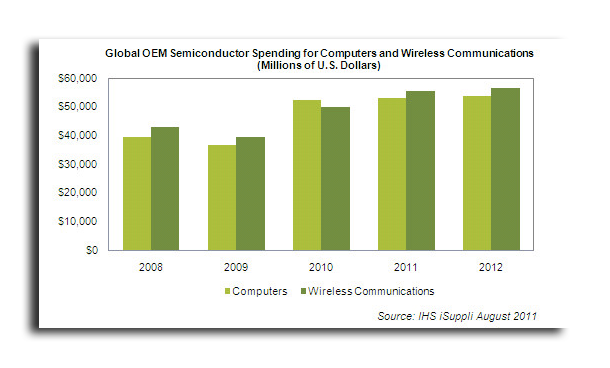Led by iPhone & iPad, sales of wireless semiconductors to top PCs in 2011
The major market-wide shift, revealed this week by IHS iSuppli, shows that wireless connected devices will become the leading category for semiconductor sales. Sales of semiconductors for wireless devices are expected to further extend their lead over sales for traditional PCs in 2012.
"Led by Apple Inc.'s iPhone and iPad, demand is booming for smart phones and tablet devices," said Wenlie Ye, analyst for semiconductor design and spending at IHS. "This is spurring a surge in sales of semiconductors used in wireless devices, including baseband chips, applications processors and mobile memory. With overall sales growth for PCs slowing, the balance of power in the semiconductor industry is shifting toward the wireless segment."
Original equipment manufacturers are projected to buy $55.4 billion worth of semiconductors for use in wireless devices in 2011. That's an increase of 10.7 percent from the $50.1 billion that were bought in 2010.
Wireless devices are expected to eclipse semiconductor sales for PCs, where 2011 sales are forecast to total $53.1 billion this year. That's just a 1.2 increase from the $52.5 billion sold in 2010.
"Thus, the supremacy of wireless as an OEM semiconductor spending category also is partly a consequence of Apple's domination of hot mobile markets — and its primacy in the electronics supply chain," the report said. It forecasts Apple to increase its lead in semiconductor purchasing over HP through 2011 and 2012.
IHS said that trends in the semiconductor industry reflect the tremendous success of Apple, which became the world's largest buyer in 2010.
Apple's ascendance to the top dethroned longtime semiconductor leader HP. The report highlighted the major differences between the two companies, as 61 percent of Apple's chip budget in 2010 was on wireless products like the iPhone and iPad, while 82 percent of HP's chip buying was devoted to traditional computers.
The figures from IHS track semiconductor spending on all OEM purchases for mobile devices, including smartphones and tablets like Apple's iPhone and iPad. The category also includes wireless infrastructure gear, like routers and base stations.
The wireless segment is differentiated from the computer segment, where semiconductors in devices like notebooks, desktops and servers are counted. The computer segment does not include chips found in peripherals like hard drives and printers.
IHS said that tablets like Apple's iPad are cannibalizing sales of traditional PCs, partially driving the industry-wide shift toward mobile platforms. Wireless devices are expected to remain the largest source of semiconductor sales for the foreseeable future.
Last October, as many prognosticators reduced their iPad sales predictions in 2011, IHS increased its forecast to 43.7 million units. However, an iPad 2 shortage at launch prompted the research firm to cut its forecast to 39.7 million in April of this year. Last quarter alone, Apple sold a record 9.25 million units of its iPad 2.
In May, IHS also predicted that Apple will continue to dominate the mobile application market for the foreseeable future, representing 76 percent of mobile application sales in 2011. The group expects Apple to retain 60 percent market share by 2014.
 Slash Lane
Slash Lane











 Andrew Orr
Andrew Orr
 Wesley Hilliard
Wesley Hilliard
 Amber Neely
Amber Neely

 William Gallagher
William Gallagher

 Malcolm Owen
Malcolm Owen








